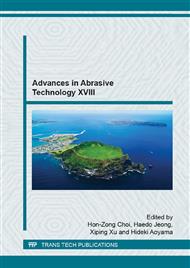p.90
p.97
p.104
p.113
p.119
p.125
p.131
p.137
p.143
Investigation of Decision Criteria for Abrasive Conditions in Multi-Small-Hole Drilling of CFRP by Blast Process
Abstract:
Composite materials, such as CFRP, are hard-to-cut materials but useful for their specific strength. Usually creating small holes in them is done using drill tools, but tool abrasion occurs early, reducing quality, raising processing costs. Comparing drilling with other processing methods, it was revealed in a previous report that it was possible to effectively create large quantities of small holes using blasting [1]. However, such blast processing involves unknown mechanisms. In the present report, we investigated the material-removing mechanisms of blasting from the viewpoint of erosion abrasion, and looked into the most suitable method by changing hole sizes and processing conditions. The results revealed, relationships between abrasive particle size and hole accuracy or hole processing efficiency as well as the optimum abrasive combinations according to hole diameter.
Info:
Periodical:
Pages:
119-124
Citation:
Online since:
January 2016
Keywords:
Price:
Сopyright:
© 2016 Trans Tech Publications Ltd. All Rights Reserved
Share:
Citation:


